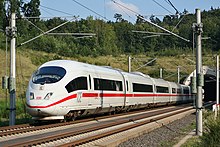
Back Triebwagen ALS عربة ذاتية الدفع Arabic Маторвагонны рухомы састаў Byelorussian Мотриса Bulgarian Unitat de tren Catalan Togsæt Danish Triebwagen German Trajnunuo Esperanto Unidad múltiple Spanish Mootorvagun Estonian
This article needs additional citations for verification. (May 2008) |


| Multiple unit trains |
|---|
| Subtypes |
| Technology |
| By country |
A multiple-unit train (or multiple unit (MU)) is a self-propelled train composed of one or more carriages joined, and where one or more of the carriages have the means of propulsion built in. By contrast, a locomotive-hauled train has all of the carriages unpowered.
An implication of this is that all the powered carriages needs to be controllable by a single engineer or driver, which is a case of the broader concept of multiple-unit train control. In other words, all "multiple units" employ some variation of multiple-unit train control. In the broader context "unit" means any powered rail vehicle, including locomotives (that does not carry cargo) and powered cargo-carrying carriages. In the context of this article, "unit" refers specifically to the latter only (whether the cargo is passengers or some other cargo).
What follows is that if coupled to another multiple unit, all MUs can still be controlled by the single driver,[1] with multiple-unit train control.
Although multiple units consist of several carriages, single self-propelled carriages – also called railcars, rail motor coaches or railbuses – are in fact multiple units when two or more of them are working connected through multiple-unit train control (regardless of whether passengers can walk between the units or not).
- ^ "Rulebook Master: Glossary of Railway Terminology, Train Working "Coupled in multiple - Traction units coupled to allow through controls by one driver"" (PDF). Rail Safety and Standards Board. Archived from the original (PDF) on 10 August 2018. Retrieved 28 September 2017.